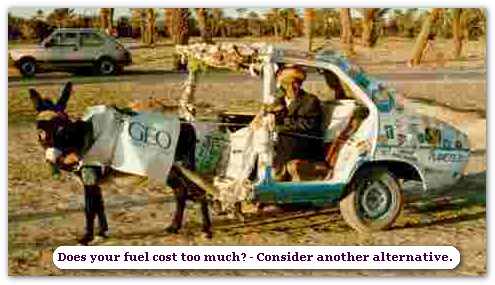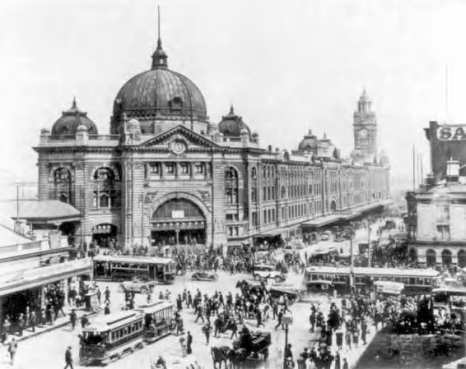
Cheapest Fuel Prices.
 |
 |
 |
 |
 |
 |
Travelling Cost Calculator
Determine an estimated overall cost of fuel for your next vacation: |
This calculator will allow you to
find the distance and driving time between two major Australian mainland cities.
Select a starting point or destination by choosing from the two drop-down lists City and Destination.
The results Distance Travelled are updated whenever you make a change to the selection in the drop-down lists.
Note: Hobart is located in Tasmania and has been included only as a guide to the relative distance from the mainland cities.
Traffic hazards encountered during the 19th century
Speeding Vehicles in Melbourne in the year of 1875
" ..police regulation forbids these.... a regulation, as might
be expected, not infrequently disregarded. We were told,
however, in all gravity by a citizen of Melbourne, that
when the municipal treasury happens to be low, policemen
are stationed at the crossings until a sufficient number of
offenders have been caught, carried off to the police office,
and fined to bring the funds up to the required level. "
Melbourne 1875 Note this article refers to a Horse driven carriage
Source: What we saw in Australia. 1875
by Rosamond and Florence Davenport Hill
Hoons in Brisbane in the year of 1876
" .... the larrikin
horsemen who gallop wildly round corners
of streets and across the main thoroughfares, utterly reckless of who or what may
be passing. "
Source: The Brisbane Courier Thursday 30 November 1876
Careless Driving 1876
" Another class of men
whose carelessness is crime are the drivers
of heavy vehicles - draymen, cabmen, and
omnibusmen included - who monopolise
the entire road, pull across to the wrong
side without warning, and enjoy the confusion, and oftentimes collisions, which
naturally ensue to people coming behind.
Source: The Brisbane Courier Thursday 30 November 1876
Speeding Taxi cabs in Sydney in the year of 1878
" Australian cabmen drive at a rattling pace, oftener
over than under the regulation, six miles an hour."
Note this article refers to a hansom cab in 1878
Source: Our Australian Cousins by James Inglis: MacMillan and Co.London
1880
BICYCLING AND PEDESTRIANS. Saturday 26 December 1896
TO THE EDITOR.
Sir.-As the number of cyclists seems
to be increasing, I think the time has
arrived when some regulations should
be issued by the authorities limiting
the speed of riders on the highroads
and main streets, and otherwise providing against accidents to pedestrians.
An eye-witness vouches for the following instance of reckless riding :
On
Saturday last, about 1 pm., on Wickharm street. near the intersection of
Brookes street, a lady was exchanging
from one omnibus to another, and in
doing so a bicycle collided with her,
grazing her arm.
No bell was sounded
by the rider, or other notice given of
his approach, and he rode off without
waiting to see the result of his clumsiness, remarking, in reply to the lady's
remonstrances, that she ought to have
got out of his way. This remark was
probably the outcome of ignorance or
impudence, or both combined, and as
such is unworthy of notice.
But if the
accident had happened to an infirm or
deaf person, or to a child, the result
might have been very serious. There
was abundance of room for the cyclist
to have passed outside either omnibus,
but he preferred to keep up his scorching pace, and to pass between the
vehicles at anybody's risk, probably
under the impression that the pedestrian
had not the greater right to the road.
On this latter point expert opinion would
be gratefully received.
-I am. sir. &c,
PATERFAMTILLAS.
The Brisbane Courier Saturday 26 December 1896
ADVICE TO CYCLISTS. Wednesday 5 November 1902
To the Editor.
Sir-Mr. Ayliffe's advice to cyclists is
good and well timed.
There is certainly too
much fast and reckless riding, but there is
another side to the question, and that is,
that many drivers of vehicles are not nearly as careful in avoiding cyclists and giving
them room as they should be.
They have
a "set" on cyclists, and take pleasure in
running them off the road, and even into
the gutter, whenever they get the chance.
Only the other day I was riding along my
proper side of the road, when the driver
of a vehicle deliberately pulled across from
the other side of the road, at a good trot,
right in front of me, causing me to run into the gutter. He. saw me coming, and
could see I was trying to avoid him, and
that I had not time to pull up.
The smile
on his face told its own tale, and being a
J.P. I had good mind to take his name
and lay an information. It would do some
drivers good to show them that cyclists
have as much right on the road as they,
and to make an example of them.
-I am,
&C CYCLIST.
The Advertiser (Adelaide, S. Aust. : 1902)
Wednesday 5 November 1902

Crowded Trains. 1881.
Sir,-About the traffic management of the Victorian railways, I recently heard a shrewd practical
man of business, well known in Melbourne, remark-
"They have not the experience out here ;
what they want is to import a man from Clapham, or Waterloo, where there is a perfect network
of rails, and where trains are in and out unceasingly. Such a man they could easily get for seven
or eight hundred a-year, and perhaps less.. He would very soon find out what's the matter."
Is not that the real remedy for unpunctual starting, overcrowded, slow trains, arriving just
too late to be in time to continue one's journey by another train, and for all the
anathematising which follows the vexation which has become too common of late?
I think so -
July15.
-Yours, &c,
HURRY UP.
Source: The Argus (Melbourne, Vic.), Monday 18 July 1881
Crowded Trains. 2009.
We should just get used to crowded trains.
Department of Transport chief Jim Betts said Melbourne was becoming more like London, Paris and Tokyo, where overcrowding was a fact of life.
"I'm not saying that's a good thing. I'm not celebrating it. But welcome to the Western world," he said.
"This is what happens when you have a city of four million people."
Source: Herald Sun Newspaper (Melbourne, Vic.) May 19, 2009
How to use this Calculator
Fill tank until it is completely full.
Set your trip odometer counter to zero or note the odometer reading.
The next time you fill up until the tank is completely full.
Make a note of how many litres needed to fill the tank.
Make a note of the odometer trip reading.
Enter these last two values into the calculator.

